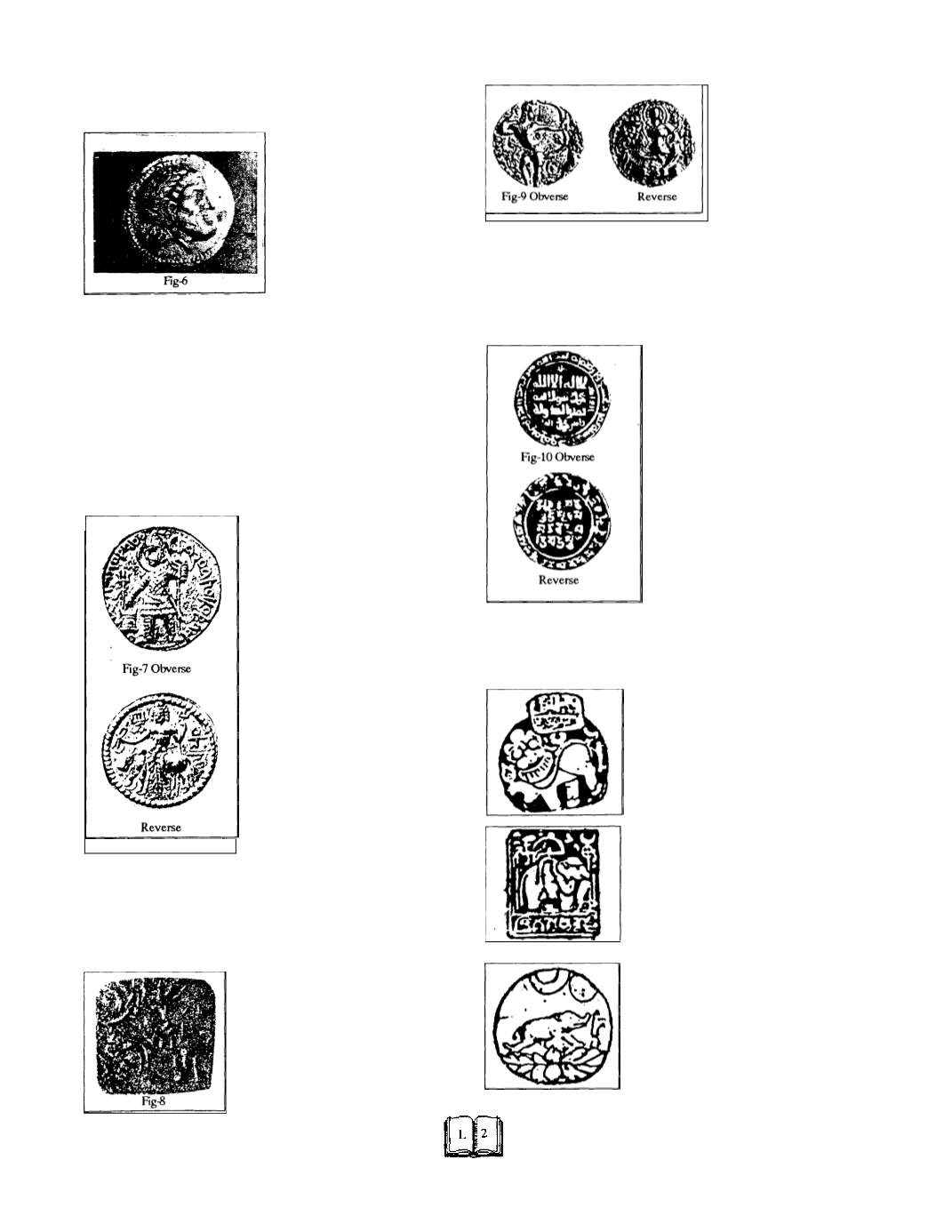

COINS
encyclopedia
with four compartments having a dot in each of them and a branch
of a tree. On the reverse some minute symbols are found.
The invasion of India by Alex-
ander the Great in 326 B.C. saw
the formation of a Greek Kingdom
in Syria which extended as far as
the Indus. The Satrap of Bactria,
the country north of the Hindu
Kush, declared his independence
of the Kingdom. Meander was the
most powerful king among the
Indo-Bactrians.
The
Indo-Bac-
trian rulers issued gold coins by
the die-striking technique which had been earlier unknown to India.
They gave a new form to Indian coinage by placing the heads of
their Kings on the obverse and introducing inscriptions on the coins
(Fig-6). They also introduced figures of Greek gods and god-
desses. A silver coin issued by Agathocles, a ruler of Bactria,
shows the head of Alexander wearing a lion's scalp with the in-
scriptions
Alexandrous
on the right and
Toy Philippon
on the left.
The reverse shows Zeus seated on the throne holding an eagle and
a long sceptre. Heads of Antiochus, Diodotus, ‘Euthydemus,
Demetrius and Pantaleon are portrayed on the coins issued by
Agathocles. Similarly Educratides commemorates his parents
Heliocles and Leodice.
The
Kushanas,
a
nomadic
tribe
known to the Chinese as Yuch-Chi,
left their homeland in the 2nd century
B.C. and settled in Bactria. A century
later, a prince of the Kue-Shuang
(Kushana) branch of the Yuch-Chi
and his successors extended their rule
up to Varanasi in the East. The earli-
est Indian Kushana coins (Fig-7)
were issued by Kujula Kadphises, the
first Kushana ruler of India, in copper.
Kujula's successor was Wima.
Wima
Kadphises
successor
was
Kanishka who issued coins only in
gold and copper. He discarded Greek
and introduced a new language - mid
Iranian. His coins bear the legend Shao
Kaneshki Koshano. On the reverse of
these coins are placed a number of
deities bearing Iranian names-Mihira
(Sun)-Mao (Moon) , Oado (wind) and Athsho (fire).
POST-MAURYAN AND PRE-GUPTA AGE
After the break-up of the Mauryan empire the new states that
were formed issued coins (Fig-8) mostly in copper, very rarely in
silver.
Some
square
or
rectangular
pieces, about one and a half inches long,
three quarters of an inch wide, bearing
five bold symbols, the sun, six-armed
symbol, three-arched symbol with a
crescent above, a J-Iike symbol, a circle
with a hook to the left, on one side and on
the other side were four punched mark
fabric of a lotus, a conch, a
solid square with four cir-
cular arms at the four
points, a strip with a cres-
cent.
The coins of the Gupta
period (Fig-9) are mostly
in gold. The most common
coin is that which shows the King standing to right, bare-bodied,
shooting at the lion with bow and arrow to one side and on the other
side is goddess seated facing on lion couchant to left, holding lotus
in the left hand and noose in the right.
DELHI MUSLIM DYNASTY
With the advent of the Muslims in
India, Indian coinage assumed an en-
tirely new pattern. In Islam, the ruler's
name on the coins was invested with
special
importance.
Muslim
rulers
started issuing coins on each occasion
when they won a war or conquered a
kingdom. The coinage underwent a
change during the expeditions of
Mahmud of Ghazni between 1001 and
1021 A.D. Most important coins of this
period (Fig-10) are silver dirhams
that bear on the obverse the Kalima.
Iltutmish issued silver coins (1211-
1236 A.D). Qutub-ud-din Aibak is-
sued gold and silver coins.
SOUTH INDIA COINS OF 10TH AND 11TH
CENTURIES
Kadamba Kings
: The characteristic
sign of the Kadamba Kings is a lion
looking backwards. They were probably
the first to strike the cup-shaped Padma-
tankas, coin has on the obverse Padma
(lotus) the eight-petalled in the centre,
with four punch-struck lions round it. The
coins weigh 58.52 grams.
Ganga Kings
.The gold coins of Ganga
Kings of Mysore had an elephant on the
obverse and floral design on the reverse.
Weights of these coins are 52.3 and 58.5
grams.
Chalukyas
: The coins of the Western
Chalukya Kings had a lion or a temple
sign in place of the lotus. They were
struck in the 11th and 12th centuries. In
1913, around 16,586 of these cup coins
were unearthed at Kodur in Nellore Dis-
trict of Madras Presidency. The weights
of these coins are 65.9 to 66.9 grams.
Eternal India
















